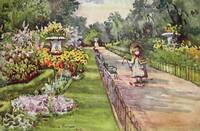The frame-ground in Regent's Park has to be a spacious one, to produce all that is required in the way of spring and summer plants. The fogs are the greatest enemies of the London gardener, and more especially on the heavier soil of Regent's Park. Not even the most hardy of the bedding-out plants will survive the winter, unless in frames. Even wall-flowers and forget-me-nots will perish with a single bad night of fog, unless under glass. Although, on the other hand, it is surprising how some species apparently unsuited to withstand the climate will survive. Among the rock plants growing in a private rock-garden within the Park Azalia procumbens, that precarious Alpine, is perfectly at home. Clumps of Cypripedium spectabele come up and flower year after year, and Arnebia echioides, the prophet flower, by no means easy to grow, seems quite established. But to return to the frame-ground, from whence all the bedding plants emanate. Violas are a special feature in the Park, and one which is much to be commended, as their season of beauty is so protracted. They are all struck in frames, one row of fifty-three lights being devoted to them, in which 23,750 cuttings are put annually. The green-houses are used for storing plants not only for the decoration of the Park but for some fourteen other places outside. The Tower, the Law Courts, Mint, Audit Office, the Mercantile Marine in Poplar, are all supplied from Regent's Park. The Tate Gallery and Hertford House have to be catered for also. Whether the visitors to the Wallace Collection even notice the plants it is impossible to say; they might miss their absence. But the gardeners have to give these few pots considerable care, as they will only stand for a very short time inside the building, and after three weeks' visit return to hospital.

